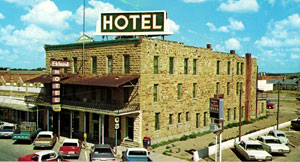Eklund Hotel
Client: Historic Eklund Hotel Association
Site: Clayton, New Mexico

The Eklund Hotel was built in 1892 in Clayton, New Mexico, by Carl Eklund, a Swedish immigrant turned cattle rancher. Once known as “the fanciest Hotel between Denver and Dallas,” the Eklund, an elegant and well-appointed hotel one block from the town’s railroad station, offered passengers a fine meal before they continued along on their journey. The hotel’s saloon supplied thirsty stockmen with libations, food, pool, poker, and lodging when they drove their cattle to town for shipment on the railroad. The Eklund continued to operate as a hotel until 1972, when the first floor saloon and restaurant were extensively remodeled, and the upper guest room floors closed to the public. In 2001, the owners of the Eklund Hotel decided to restore the hotel to its once great refinement of previous years. The Collaborative was retained to evaluate the building’s condition, design improvements, project restoration and preservation costs, prepare tax credit applications, manage construction phases, and restore the interior to its original opulence. Our firm completed a Historic Structures Report, mortar and paint analysis, and prepared the application for placement of this hotel on the National Register. Designs were completed for expanded dining facilities, a kitchen remodel and expansion, guest room renovations, public restroom designs to meet modern needs, and the addition of a new elevator. This project’s challenges were both numerous and tough. The work completed in 1975 focused on first floor use but, ignored the possibility of guest room re-use. Steel columns and beams reinforced the first floor, while the upper floors were not touched. As a result, all of the floors exhibited significant structural problems, being out-of-level by as much as three inches to three feet. The sandstone exterior had never had any significant repair work, which resulted in substantial deterioration. In addition, the earlier first floor renovation was rather insensitive to historic materials. Fortunately, it was reversible. The preservation and renovation plans addressed these issues and the project gained state and federal funding, as well as state and federal historic tax credits. Today the restaurant and saloon still thrive on the trade of the traveler, and the local stockmen who continue to drive their cattle to town. Now completed, the modern-day-visitor is able to drink in the saloon, enjoy a steak dinner in the dining room, and retire to the comforts of a historic guest room with modern conveniences. This historic landmark has been returned to its previous stature and in so doing, preserves a building of local and national significance.
